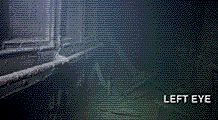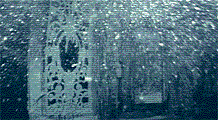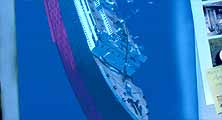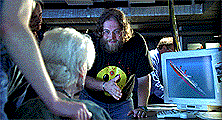|
About Our Work
For James Cameron's epic love story set aboard the doomed luxury liner, BFTR performed a myriad of effects duties, ranging from basic compositing and video overlays to CG modeling/animation and complex image manipulation. While the folks at Digital Domain were charged with the responsibility of creating the major visual effects for the film, they were ultimately joined by a dozen and a half other effects houses in their efforts, ranging from rival Industrial Light & Magic to little ol' Banned From The Ranch.
Although originally brought on to create a simple camcorder viewfinder-style overlay, BFTR ended up providing nearly fifty shots for the film.
 Our simplest shots for TITANIC were a series of digital video manipulations, in which original Betacam material from both the production shoot and the actual Titanic wreck dive had to be processed, color-corrected and overlaid with graphics to achieve a realistic video look on film. When it became clear that BFTR could handle more than simple shots, both Jim Cameron and visual effects producer Camille Cellucci began adding more and more shots to BFTR's plate. Our simplest shots for TITANIC were a series of digital video manipulations, in which original Betacam material from both the production shoot and the actual Titanic wreck dive had to be processed, color-corrected and overlaid with graphics to achieve a realistic video look on film. When it became clear that BFTR could handle more than simple shots, both Jim Cameron and visual effects producer Camille Cellucci began adding more and more shots to BFTR's plate.
 
BFTR processed a series of video shots --some taken at the actual wreck and others shot on an underwater set-- for both color correction and simple graphic overlays.
©1997 Paramount/Fox
|
For the scene near the beginning of the film where Old Rose is shown a computer simulation of the liner's sinking, Digital Domain created a stunning 2700-frame CG animation; BFTR was asked to composite the DD animation into a


Two of our CG composite shots, in which we placed Digital Domain's computer simulation of the Titanic's sinking onto a monitor in the scene; the top image's monitor frame had to be created from scratch.
©1997 Paramount/Fox
|
greenscreened computer monitor in the live action footage. The scene had not
yet been edited when BFTR was assigned to it, so a placeholder of twelve shots was allotted, which was to be pared down as the scene was put together.
With only a week to go before temp effects shots were needed for a crucial screening, the scene was finally edited and locked... with eighteen effects shots, ranging from 30 frames to over 300 frames per shot. Although already sandwiched between effects duties on several other major effects films (including SPAWN and STARSHIP TROOPERS), visual effects supervisor Van Ling was able to input, track, image-process and composite the digital animation provided by DD with the live-action footage by himself in two days using Adobe After Effects at full film resolution, and the production was able to include the near-final effects sequence in the preview screening.
In all of the CG monitor shots, the DD material--rendered at 1K resolution--had to be color-balanced and processed with video raster lines to look like a computer screen image, then tracked and corner-pinned into the scene. Even the full-screen shots of the monitor image required manipulation, since Jim Cameron had made liberal use of the animated repositioning and resizing feature of the Avid Film Composer on which he, Conrad Buff and Richard A. Harris, edited the picture.
While this capability of the Avid non-linear editing system gave the director/editor more freedom and choices, we discovered that the medium closeups of the monitor had been created by blowing up the wide shots by 400%! While this had looked acceptable in a low-resolution digital edit, it was way too grainy to use in the final film, so Van had to recreate the medium closeup footage from scratch, by painting a high-resolution monitor frame in Adobe Photoshop--reproducing not only the monitor itself but also the Post-It notes and Titanic photos that decorated the monitor on the set--before he could composite the DD animation. continued...


Banned From The Ranch Entertainment Home Page
����General Information: info@bftr.com
|

